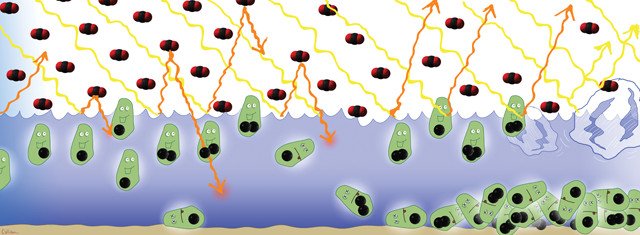
by Sarah Derouin Friday, October 12, 2018

A new study suggests that enhanced burial of carbon from eukaryotic algae drew down atmospheric carbon dioxide levels during the Ordovician, resulting in a diminished greenhouse effect that triggered an ice age and a mass extinction. Credit: Callan Bentley, 2018.
Errant asteroids and toxic emissions from volcanic eruptions are the usual suspects in mass extinctions. But during the Ordovician, it was a million-year stretch of cooling ushered in by proliferating algae that triggered a worldwide glaciation and extinction event, according to a new study.
The Hirnantian mass extinction occurred during the Late Ordovician about 445 million years ago and was the first major extinction event of the Phanerozoic. The extinction hit shallow-water marine creatures especially hard, with 26 percent of families and 49 percent of genera disappearing.
Previous research has suggested that changes in atmospheric carbon dioxide levels — brought on by changes in the carbon cycle, increased volcanic activity or increased weathering of land as terrestrial plants developed — triggered the Hirnantian extinction and an ensuing ice age. These processes would have driven more nutrients into the sea, increasing the productivity of marine algae, says Ann Pearson, a biogeochemist at Harvard and co-author of the new study in Nature Geoscience. But these scenarios don’t fully explain the global changes that occurred at the time, she adds. The challenge, she says, was connecting the algae to carbon storage, especially over a million years or more.
Previous studies looked at lipid biomarkers in, and the inorganic chemistry of, Ordovician rocks. Pearson and her colleagues used similar approaches but also found residues of both bulk organic matter and molecules called porphyrins — leftover chemical products of photosynthesis — preserved in rock from the Ordovician Vinini Creek section in Nevada. Together with carbon and nitrogen isotopic data also gleaned from the rock, the porphyrins the researchers detected allowed them to estimate how both algae and marine cyanobacteria were faring just before the Hirnantian extinction.
The team found that algae living just before the Hirnantian were plentiful — and big. “Our new data specifically point to an expansion of eukaryotic algal cells relative to cyanobacterial cells,” Pearson says. Eukaryotes are larger than cyanobacteria, and they sink faster through the water column — consistent with the idea that biomass and carbon burial would have increased as populations of eukaryotic algae grew. “The faster an algal cell reaches the sediment, the higher the percentage of its carbon that will ultimately be buried rather than quickly recycled back to [the atmosphere as] carbon dioxide,” Pearson says.
As more carbon was sequestered from the atmosphere and buried, the planet cooled. And the porphyrins preserved in Vinini Creek rocks are the proof of this process.
It’s “quite exciting” to see a study detailing porphyrins found in ancient rocks, says Amber Jarrett, a geochemist with Geoscience Australia who was not involved with the study. Porphyrins are big molecules that easily break down over geologic time into smaller molecules called lipids. When looking at rocks from deep time, she says, “it’s rare to find such well-preserved molecules.”
Explosive growth of ancient algae, like that documented by Pearson and her co-authors, is not unheard of. Jarrett points out that after the near-global glaciations of the Proterozoic called “Snowball Earth” events, there was so much phosphorus (from glacial erosion of continents) and food in the water column that algae gorged themselves, leading to large-scale burials of carbon. But the Ordovician is different. “In this case, it’s like [algae] had this huge party and then caused their own glaciation,” she says. “Basically, they ate themselves to their own demise.”
The work highlights the important interactions between biological activity and physical processes like changes in sea level and sedimentation, Pearson says. “Changing biology on its own was insufficient to trigger this climate event,” Pearson says. “But similarly, the geological processes by themselves cannot create enough of a perturbation in the carbon cycle.” Instead, it took a combination of factors to send the planet into a glaciation.
The team’s approach is a great example of how multiple proxies can be used together to recreate past environments, Jarrett says. “They’ve taken the inorganic chemistry, the isotopes, the porphyrins, and used the biomarker work that’s been done [before] — all of these things stack up and tell the same story” of a drawdown of atmospheric carbon — and consequently a cool down — during the Late Ordovician.
Jarrett says studies like this can help scientists understand future as well as past climate change, and that there are also industrial applications of reconstructing past algal blooms, which degrade over time to produce petroleum deposits. In this case, a massive algal bloom was followed by a global glaciation. “These glacial units [like those found in the Hirnantian glaciation] are really thick and really identifiable,” Jarrett says, explaining that finding glacial markers may allow identification of potential basins for future petroleum exploration.
© 2008-2021. All rights reserved. Any copying, redistribution or retransmission of any of the contents of this service without the expressed written permission of the American Geosciences Institute is expressly prohibited. Click here for all copyright requests.